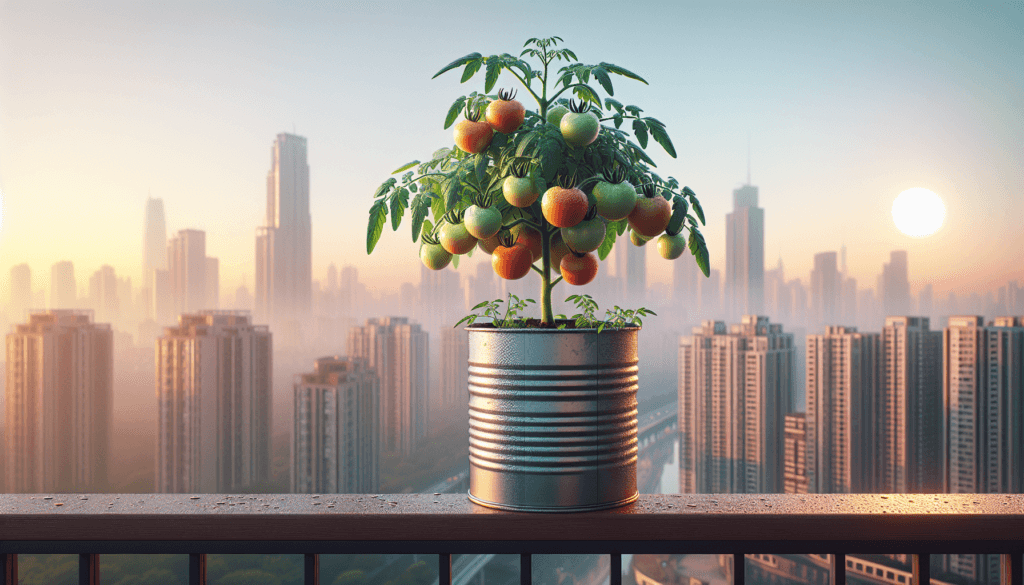Imagine having the ability to step out onto your city balcony or into your small backyard and pick fresh, homegrown produce all year round. No longer a mere fantasy, designing an urban garden for year-round harvests has become an attainable reality for those living in tight urban spaces. By utilizing innovative techniques such as vertical gardening and container gardening, you can maximize your limited space, make efficient use of resources, and enjoy a bountiful harvest regardless of the season. In this informative article, we will explore the key principles and practical steps to create an urban garden that defies traditional limitations and provides you with fresh, nutritious produce throughout the year. Get ready to embark on a journey of urban gardening like never before!

Choosing the Right Location
When designing an urban garden for year-round harvests, one of the first and most important steps is choosing the right location. The success of your garden largely depends on the available space, sunlight exposure, and soil quality.
Consider the available space
Before starting your garden, assess the available space in your urban setting. Whether you have a small balcony, a rooftop, or a backyard, consider how much space you have and how it can be optimized for gardening. Take notes on the dimensions and layout, and consider how you can make the most of the available area.
Evaluate the sunlight exposure
Sunlight is crucial for the growth and development of your plants. Evaluate the sunlight exposure in your chosen location. Observe how much direct sunlight the area receives throughout the day and identify any shady spots. Most vegetable crops require at least six hours of direct sunlight daily, so choose a location that receives adequate sunlight for your chosen crops.
Assess the soil quality
The soil quality plays a significant role in the success of your urban garden. Assess the soil in your chosen location to determine its fertility and composition. Consider factors such as drainage, pH levels, and nutrient content. If the soil is poor, you may need to amend it with organic matter, such as compost or manure, to improve its fertility and structure. Conducting a soil test can provide valuable insights into its composition and help you make informed decisions regarding soil amendments.
Selecting Suitable Crops
Once you have chosen the right location, the next step is to select suitable crops for your urban garden. Several factors come into play when choosing crops, including climate zone, year-round growth potential, and your family’s preferences.
Determine the climate zone
Before deciding on specific crops, determine the climate zone in which your urban garden is located. Find out the average temperatures, frost dates, and weather patterns for your region. Different crops have different temperature and seasonal requirements, so understanding your climate zone will help you select crops that thrive in your area.
Research crops for year-round growth
To achieve year-round harvests, consider selecting crops that can grow in different seasons. Look for vegetables and herbs that can tolerate both cool and warm temperatures. Some examples include lettuce, kale, Swiss chard, carrots, and radishes. Additionally, consider growing perennial herbs like rosemary, thyme, and sage, which can provide continuous harvests throughout the year.
Consider your family’s preferences
When selecting crops for your urban garden, it is essential to consider your family’s preferences. If certain vegetables or herbs are favorites among your family members, prioritize growing those. Consider any dietary restrictions or preferences and choose crops that align with them. Having a variety of crops that are enjoyed by your family will increase the satisfaction of your garden and encourage everyone to participate in its maintenance and harvest.

Planning the Layout
Now that you have chosen your crops, it’s time to plan the layout of your urban garden. A well-organized layout will maximize space utilization and make gardening more efficient.
Divide the garden into zones
Dividing your garden into zones can help you manage the space effectively. Consider grouping crops with similar water and sunlight needs together. For example, create a zone for sun-loving vegetables and another for shade-tolerant herbs. By doing so, you can easily manage each zone’s specific requirements and provide optimal growing conditions for every crop.
Allocate space for each crop
Once you have divided your garden into zones, allocate space for each crop within those zones. Consider the mature size of each plant and leave enough room for them to grow without overcrowding. Proper spacing allows air circulation, reduces disease penetration, and enables easier access for harvesting and maintenance. Consult seed packets or gardening resources to determine the recommended spacing for each crop.
Incorporate companion planting
Companion planting is a gardening technique that involves planting compatible crops together to promote healthy growth and deter pests. Take advantage of this technique in your urban garden. For example, consider planting marigolds alongside tomatoes to deter nematodes or interplant basil with peppers to repel aphids. Companion planting can help create a harmonious and balanced garden ecosystem.
Utilizing Vertical Space
Urban gardens often have limited horizontal space, so utilizing vertical space is a great way to maximize your garden’s potential. There are several ways to utilize vertical space effectively.
Install trellises and arbors
Trellises and arbors are excellent additions to your urban garden. They provide support for climbing plants and allow you to grow vertically. Install trellises and arbors along walls, fences, or in designated areas to provide support for vining crops like tomatoes, cucumbers, and pole beans. This not only saves space but also adds visual interest to your garden.
Opt for vertical planters
Vertical planters, such as hanging baskets or vertical garden towers, are efficient ways to grow plants vertically. These planters can be hung on walls, railings, or suspended from ceilings, making them ideal for small urban spaces. Choose planters with built-in irrigation systems to ensure proper watering for your crops.
Train vines and climbers
Apart from utilizing trellises and vertical planters, consider training vines and climbers to grow vertically. For example, train tomato plants to grow on a stake or weave cucumber vines around a trellis. Training plants to grow vertically not only saves space but also improves air circulation and reduces disease risks.

Implementing Season Extension Techniques
To have a year-round garden, implementing season extension techniques is essential. Extending the growing season allows you to grow crops outside their natural seasons and enjoy fresh produce for a longer time.
Construct a greenhouse or hoop house
Constructing a greenhouse or hoop house is a great way to extend the growing season. These structures provide a controlled environment that allows you to grow crops even during colder months. Greenhouses provide insulation, retain heat, and protect plants from harsh weather conditions. Hoop houses are similar, but are usually smaller and made with less expensive materials.
Use row covers and cloches
Row covers and cloches are lightweight covers that can be placed over individual rows or plants. They provide protection from frost, temperature fluctuations, and pests. Using row covers and cloches can help extend your growing season by creating a microclimate around your plants, allowing them to continue growing even when temperatures drop.
Make use of cold frames
Cold frames are a simple and effective way to extend the growing season. These structures consist of a transparent top and an insulated frame. By capturing the sun’s heat, they create a warm environment for plants. Cold frames can be used to start seedlings earlier in the spring or to protect them from frost as temperatures begin to drop in the fall.
Ensuring Proper Irrigation
Proper irrigation is crucial for the health and growth of your plants. Consistent watering ensures that your crops receive enough moisture, promoting vigorous growth and preventing stress-related problems.
Install an efficient irrigation system
Consider installing an efficient irrigation system to simplify watering tasks. Drip irrigation systems, for example, provide water directly to the plants’ roots, reducing water waste and minimizing weed growth. Install timers and moisture sensors to automate the irrigation process and ensure that your plants receive water at the appropriate times.
Consider rainwater harvesting
Take advantage of rainwater by implementing rainwater harvesting techniques in your urban garden. Set up rain barrels or a rain collection system to capture rainwater from your roof or gutters. This water can then be used to irrigate your plants, reducing your reliance on municipal water supplies and conserving resources.
Monitor soil moisture levels
Regularly monitor soil moisture levels to ensure your plants receive adequate water. Use a moisture meter or simply insert your finger into the soil to a depth of a few inches. If the soil feels dry, it’s time to water. Be mindful not to overwater, as this can lead to root rot and other problems. Adjust your irrigation schedule accordingly based on the weather conditions and the specific needs of your crops.

Managing Soil Health
Healthy soil is the foundation for a successful urban garden. Implementing practices that promote soil health is essential for the long-term productivity and sustainability of your garden.
Perform regular soil testing
Regular soil testing is crucial for understanding the nutrient content and pH level of your soil. Testing your soil allows you to identify any deficiencies or imbalances and make appropriate amendments. Follow the instructions provided by your local extension service or gardening center to collect a soil sample, and send it for analysis. Based on the results, you can add organic matter or specific fertilizers to improve soil fertility and balance.
Enrich the soil with compost
Compost is a valuable source of organic matter and nutrients for your soil. Enrich your soil by adding compost regularly. Compost improves soil structure, enhances water retention, and provides essential nutrients to your plants. Start a compost pile in your urban garden or explore other composting methods, such as vermicomposting or bokashi composting, to produce nutrient-rich compost for your garden.
Implement crop rotation
Implementing crop rotation is an effective technique to manage soil health and reduce the risk of pest and disease buildup. Different plant families have different nutrient requirements and susceptibility to pests and diseases. By rotating crop families each season, you can prevent nutrient depletion and break the lifecycle of pests and diseases. Plan a rotation schedule that allows for a diverse range of crops and minimizes the risk of common garden problems.
Controlling Pests and Diseases
Pests and diseases can pose significant challenges in any garden, but with proper pest management techniques, you can minimize the impact and keep your plants healthy.
Practice integrated pest management
Integrated pest management (IPM) is an approach that combines various techniques to control pests and diseases. Instead of relying solely on chemical pesticides, use a combination of cultural, mechanical, and biological methods. These can include practices such as handpicking pests, using barriers or traps, encouraging natural predators, and practicing good sanitation in your garden. By adopting an integrated approach, you can effectively manage pests while minimizing harm to beneficial insects and the environment.
Encourage beneficial insects
Beneficial insects, such as ladybugs, lacewings, and hoverflies, are natural predators of pests and can help control pest populations in your garden. Create a welcoming environment for these beneficial insects by planting flowers and herbs that attract them, such as marigolds, dill, and yarrow. These plants provide nectar and shelter, attracting beneficial insects to your garden and promoting a balanced ecosystem.
Apply organic pest control methods
When pest problems arise, consider using organic pest control methods to address them. Organic pesticides derived from natural substances, such as neem oil, garlic, or soap solutions, can be effective against certain pests. Additionally, homemade remedies like companion planting, using reflective mulches, or applying organic pest repellents can help deter pests. Research and experiment with organic pest control methods to find what works best for your specific pest issues.

Harvesting and Storing
The joy of a year-round urban garden lies in harvesting the fruits of your labor. Proper harvesting and storage techniques ensure that your produce stays fresh and flavorful for as long as possible.
Harvest crops at their peak
To enjoy the best flavor and nutritional value, harvest your crops at their peak of ripeness. Different crops have different indicators for harvest readiness. Some fruits and vegetables should be picked when fully mature, while others can be harvested at different stages of ripeness. Refer to gardening resources, seed packets, or consult experienced gardeners to learn the signs of readiness for each crop.
Properly clean and store produce
After harvesting, it is essential to properly clean your produce to remove dirt, bacteria, and any potential pests. Rinse vegetables and fruits gently under cool, running water. For longer storage, consider using a mild, eco-friendly vegetable wash. After cleaning, allow the produce to dry completely before storing. Remove any damaged or spoiled pieces to prevent them from spoiling the rest of the harvest.
Preserve excess harvest through canning or freezing
If your harvest yields more than you can consume fresh, consider preserving the excess through canning or freezing. Canning involves processing produce in jars with the use of heat to kill bacteria, yeasts, and molds. Freezing involves blanching vegetables briefly, then sealing them in airtight containers or bags. Both methods allow you to enjoy the flavors of your garden throughout the year and reduce food waste.
Maintaining Year-Round Garden
To maintain a year-round garden that consistently produces bountiful harvests, ongoing care and attention are necessary.
Regularly monitor plant growth
Regular monitoring of your plants’ growth allows you to detect any issues early on and address them promptly. Check for signs of nutrient deficiencies, pest or disease damage, or any signs of stress. By catching problems early, you can take the necessary steps to remedy them and prevent them from spreading to other plants.
Prune and trim as needed
Pruning and trimming plants are essential tasks for maintaining their health and shape. Remove dead or damaged branches, as well as any overgrown or tangled growth. Pruning encourages healthier growth, improves air circulation, and reduces the risk of pest and disease problems. Refer to specific pruning guidelines for each plant type to ensure you are pruning correctly.
Replace spent crops with new ones
As one crop finishes its lifecycle, replace it with a new one to ensure continuous harvests. Succession planting is the practice of planting new crops as soon as the previous ones are harvested. This allows you to maximize your garden’s productivity and enjoy fresh vegetables throughout the year. Plan your planting schedule accordingly, taking into account crop maturity dates and seasonal requirements.
Designing an urban garden for year-round harvests requires careful consideration and planning. By choosing the right location, selecting suitable crops, planning the layout effectively, utilizing vertical space, implementing season extension techniques, ensuring proper irrigation, managing soil health, controlling pests and diseases, harvesting and storing produce correctly, and maintaining the garden year-round, you can create a thriving garden that provides a continuous supply of fresh and delicious produce. With dedication and a friendly approach, you can enjoy the rewards of your urban garden throughout the year. Happy gardening!


